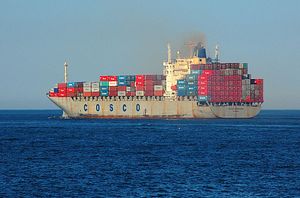As my colleague Shannon Tiezzi reported a while back, the Chinese government has approved a plan to ensure that civilian vessels can support military operations of China’s maritime forces in the event of a crisis.
While the recruitment of civilian maritime assets for military purposes is not unusual (e.g., the Queen Elizabeth 2 transported the main British land fighting force to the Falkland Islands during the 1982 Falklands War), the recent announcement is nevertheless a sign of the growing aspirations of Chinese naval planners in developing naval expeditionary warfare capabilities.
According to the Chinese Ministry of National Defense’s website, China’s national transport war-preparedness office for national defense recently held a training session for Chinese shipping enterprises to familiarize the civilian shipping sector with a set of new guidelines, the Technical Standards for New Civilian Ships to Implement National Defense Requirements, in early June in Shanghai.
This document lays out the specific requirements for newly constructed civilian vessels to meet “national defense requirements”, the ministry website states. The guidelines, which were already approved in March 2015, are the result of a five-year research project by the Shipment Military Representative Office of the PLA Nanjing Military Area Command (MAC) and the CCS Shanghai Specification Institute.
In detail, the guidelines, next to a set of general rules sections, discusses five categories of vessels: container ships, roll-on-roll-off ships, multipurpose ships, bulk cargo ships, and general cargo ships. These ship categories indicate that the principal reason behind these new guidelines is the strengthening of the People’s Liberation Army Navy’s expeditionary warfare capabilities.
“The implementation of this military standards for civilian ships makes it possible for China to turn the great potential of its civilian ships quickly into military strength for national defense and will considerably enhance the PLA’s strategic projection capability and maritime support capability,” the website states.
This would be in line with China’s recently published defense white paper, which elaborates on Chinese aspirations towards a blue-water navy and an increased Chinese naval presence outside territorial waters:
In line with the strategic requirement of offshore waters defense and open seas protection, the PLA Navy (PLAN) will gradually shift its focus from “offshore waters defense” to the combination of “offshore waters defense” with “open seas protection,” and build a combined, multi-functional and efficient marine combat force structure. The PLAN will enhance its capabilities for strategic deterrence and counterattack, maritime maneuvers, joint operations at sea, comprehensive defense and comprehensive support.
A Reuters story on the new guidelines quotes a researcher from the PLA Naval Military Studies Research Institute who provides additional details on China’s naval plans:
Modern naval warfare often requires the mobilization and deployment of a large number of ships while the mass production of naval ships in peacetime is not economically sensible. Therefore, it is a common practice that shipbuilders reserve some military application platforms on their civilian vessels so they can serve the navy in wartime.

































